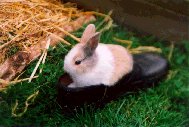Taking care of a rabbit
SAFETY IN THE HOME
Before you let out the rabbit in your home, you have to look after, that there is a "rabbit safe" area, where it can run around.BITING: The teeth of a rabbit are growing the whole time, so the rabbit has a tendency to bite in many different things. For the safety of your rabbit and for you to be calm: try to hide electric wires.
Donīt let your rabbit bite in your carpet. There might come pieces of it in the rabbitīs stomach, and it is not good for it.
PLANTS: Place the pot plants so that the rabbits canīt reach them. Some plants are harmless, while leaves, flowers and berries from others might be poisonous for your rabbit.
OTHER PETS: If you have other pets in the home, then keep them away from the rabbit, till they have got used to each other. Remember: Some pets never get used to each other and have to be kept separated. Remember to wash your hands, if you just have fondled a pet, that might have parasites or fleas, and you want to pet your rabbit hereafter.
ORDINARE SAFETY: Cut the nails of the rabbit with intervals, so that it doesnīt get caught in a carpet or in your shirt or so that it doesnīt break its nails, when it runs around or hops. If you clean the room where the rabbit is places, and you use something smelling very strong, you should move the rabbit to an other room, till the room has been aired.
Rabbits can hop, so donīt let them be alone, when they are at a table or an other high place, where they can fall down.
HOW TO HANDLE THE RABBIT
Handle your rabbit with love and care. Donīt keep it too long in your arms, because it can be too warm for the rabbit. Remember rabbits canīt bark or purr, so if they are dissatisfied with something, they can only show it by scratching, biting or by squirming.NEVER HIT YOUR RABBIT! It will learn, if you give it your love, never if you are tough to it.
NEVER TAKE YOUR RABBIT IN THE EARS!
NEVER TAKE YOUR RABBIT THE SCRUFF OF THE NECK OR IN THE BACK! It hurts your rabbit to be taken in a wrong way, and the rabbit might not want to come up to you at all.
The right way to take a rabbit:
- Put your one hand under the bottom of the rabbit and the other under its breast.
- Lift the rabbit up to you.
- Support the rabbit with one hand under the bottom and one hand loose around the neck.
- Hold the rabbit safe, but not too tight.
- If the rabbit starts jumping or falling, you have to go down in your knees, so that it doesnīt fall too long.
- Never hit, slap or tease your rabbit, and donīt hold it into you too long, it might get aggressive of it.
- When your rabbit has got used to you and it is completely familiar with you, maybe you can make it to lie as ababy in your arms.
- Always treat your rabbit with love.
THE CARE OF A RABBIT
 "Mads Godt" and "Ninka" (mother).  "Ragout" is shedding his hair. |
The claws of the rabbit are growing the whole time, and they have to be cut about every ― year.
You can use an ordinary nail cutter, but a good cutter designed for rabbits or dogs is easier to use. Cut only the tip of the claws. There is a vein in the claw, and in a light claw you can see it. In dark claws it is more difficult, so pay attention that you only cut a little at a time. If you are uncertain to cut the claws of the rabbit, then let a vet or a breeder do it for you.
HOW TO TIDY UP THE RABBIT:
The rabbit loses hair the whole time just like cats and dogs, but twice a year it will shed a lot. You can brush it about twice a week; when it sheds more often. Rabbits tidy themselves up by licking the fur or by scratching itself with the paws. When it licks the fur or the paws, it can get a great deal of hair in its mouth, and at last it can get a wool ball in its stomach. You can avoid it by brushing your rabbit.
BATH:
Rabbits only need a bath, if they have got very dirty for some reason or other (diarrhoea or if an other rabbit has squirted at it). If your rabbit has to be washed, then only wash the part of the rabbit that is dirty, NOT THE WHOLE RABBIT. Be careful that the rabbit doesnīt get water in the ears and eyes.
The best way to keep your rabbit clean is to keep its cage clean and dry.
HEALTH
SIGN OF A GOOD HEALTH:A curios and watchful rabbit with clean ears, clear eyes, good appetite, a shining coat without scurfs, the front teeth at the top just have to go down under the edge of the front teeth at the bottom, the rabbit has to be clean in its behind, and the poohs have to be firm. ( rabbits make two kinds of poohs: the firm ones and some moistened, soft vitamin-containing poohs, which the rabbit eats again.)
SIGHNS AT ILLNESS:
Mucus from eyes and nose, constantly sneezing, rumbling sounds of air, diarrhoea, no poohs at all, very tiny poohs, dislike of eating and drinking, inflammation from the sex organs, inflammation and scabs around the nose, bald spots, which do not come from shedding, dry or scurfy skin, dirty ears or wax lumps in the ears, difficulty by walking, constantly carry itīs head on one side, croked or broken teeth, the teeth in the buttom growing in front of the teeth in the top, abscesses, raw or bleeding pads on the paws.
HOW TO KEEP YOUR RABBIT IN GOOD HEALTH:
Feed with fresh pellets (never moist or mouldy pellets) and donīt give too many tidbits (the rabbit will get fat). Cut down the feed if necessary, if you give much fresh feed (carrots, beets, apple branches etc.) Look after that the rabbit has clean water the whole time, wash cups and bottles at least once a week, keep the cage clean and change the straw in the cage at least once a week. Keep mice and rats away from the rabbitīs cage and its feed and put the rabbitīs cage in a place with good ventilation without draught. Even if your rabbit is placed in a cage in the garden, you can easily take it indoor once in a while. You just have to remember not to keep it indoors too long time at a time. If it is very cold outside, you shouldnīt take it in, because the difference in temperature might be too big for your rabbit. In the winter you can just take into a not warmed up room.
This is only meant as a help to give you little knowledge about, what might be the matter with the rabbit. If your rabbit gets ill, you have to contact your vet.
DO YOU WANT TO BREED?
To breed rabbits takes responsibility. If you have a male and a female, there might happen a little mishap, if you are not careful. An active male can find the female very quickly. He can even bite through a thin wall to find her, and the actual mating just takes some few seconds.The Rabbits pregnancy is about 31 days.
Today there are too many people, who for some reason or other want to breed rabbits. Some people, who have 2 pet rabbits think, it will be "so sweet" for their children that the rabbits get young. Often they have not thought about what to do to the young. Very often the young go together too long time.
We do not recommend that you get rabbit young, if you not beforehand have found buyers for all the young - the mother rabbit can get 5-8 young.
There are people, who only breed to sell the young under miserable circumstances at fairs. There are also serious breeders under a breeding association, who sells at fairs, but they very often shows, that they are in an association, and you can also recognize them on, that they sell their rabbits under good circumstances.
There are many things to think at, if you want to breed.
 When you are little, you can just lie in a clog.  When the young are out together with their mother, they like huddling together. |
- Are the male and the female old enough?
They have to be 6 month old. If you use younger rabbits, they might not get young.
- How often can a rabbit get young?
A breeder sometimes let a rabbit get young 3 - 4 times a year. Then she can make recovering before next litter, and she will be able to get young still many years. If she gets mated just when a litter is weaned or before, it might drain her for energy and necessary vitamins.
- Is it good to let the two rabbits, you are thinking of, have young together?
If it is a brother and a sister, a mother and son, a father and daughter etc. you breed of, there might be a risk for genetic deformations. Breeders, who want to breed something special, do it, but they know what they do, and they know about the heredity.
- If it is different breed of rabbits, do they fit each other?
If a great male is mated with a little female it might give some problems at the birth. You also risk getting some mixed rabbits, which nobody wants.
- Are you ready for breeding?
Do you have enough cages to keep the males and the females parted? The femaleīs cage has to be big enough also for the young. The young can go together with the mother till they are sexually mature. When the young get older, they have to get each their cage.
- Can you afford getting young?
Every time a rabbit get young, you might need a vet. You have to be able to afford it; the rabbitīs live might depend on this.
- What is going to happen with the young?
When the young are old enough to leave the mother, you have to decide what to happen with them. If you want to keep some of them, you must have a cage for them. If you donīt have a plan before you breed, it is best not to get young. If you have rabbits of both sexes, you might have a mishap. The male are often very ingenious to find the way to a female, and if you have had a mishap, you have to handle it all the best way.
